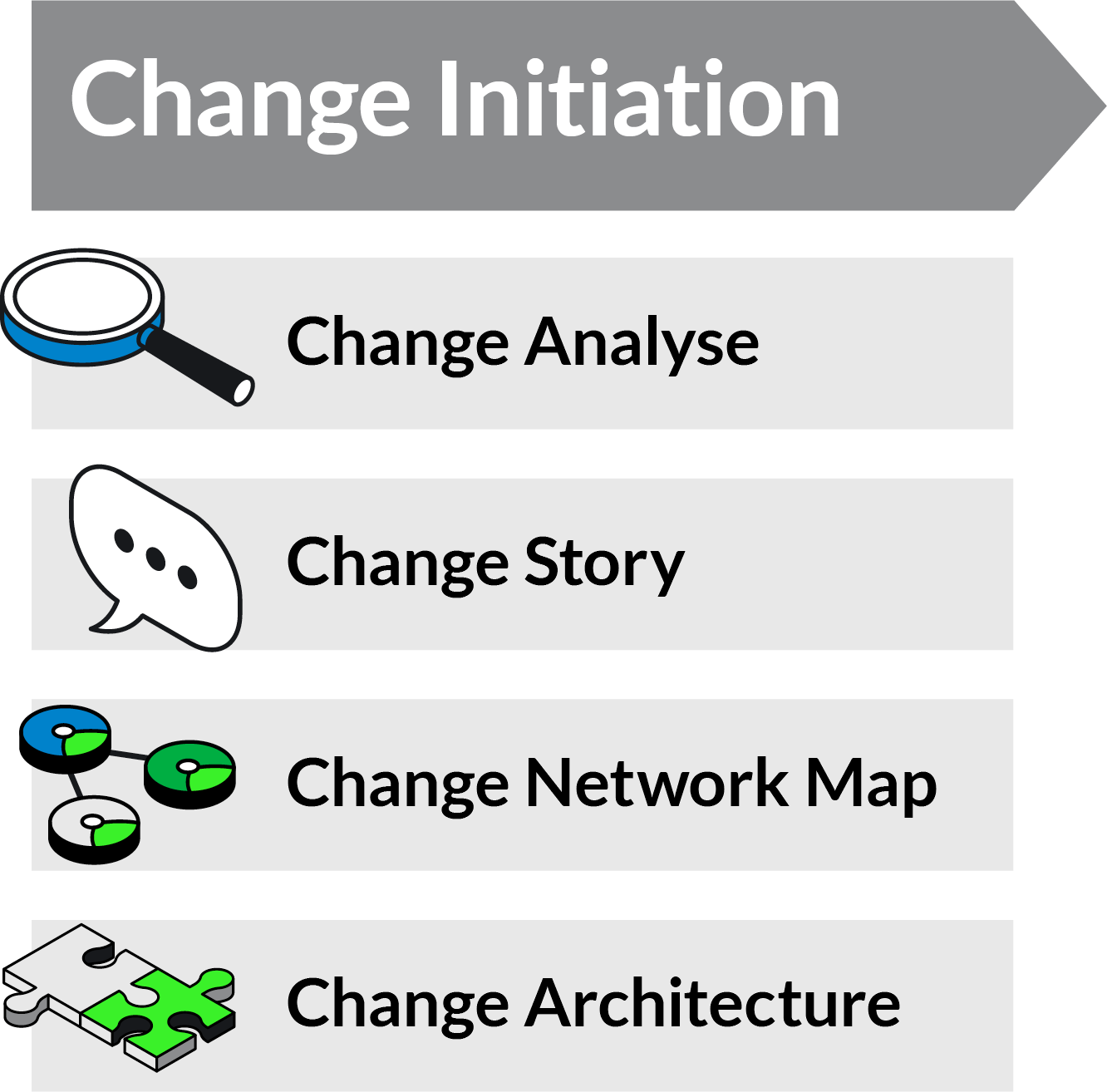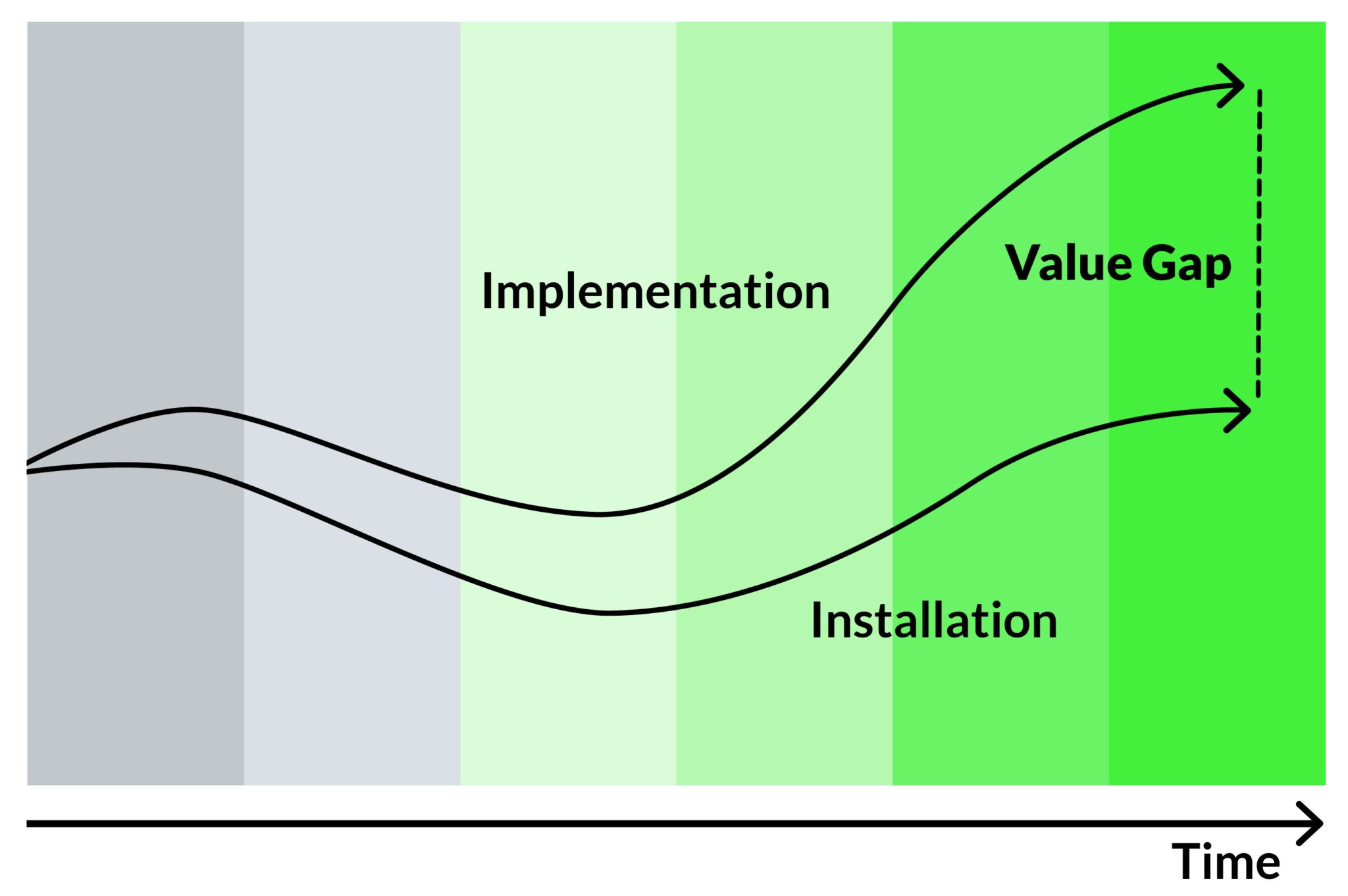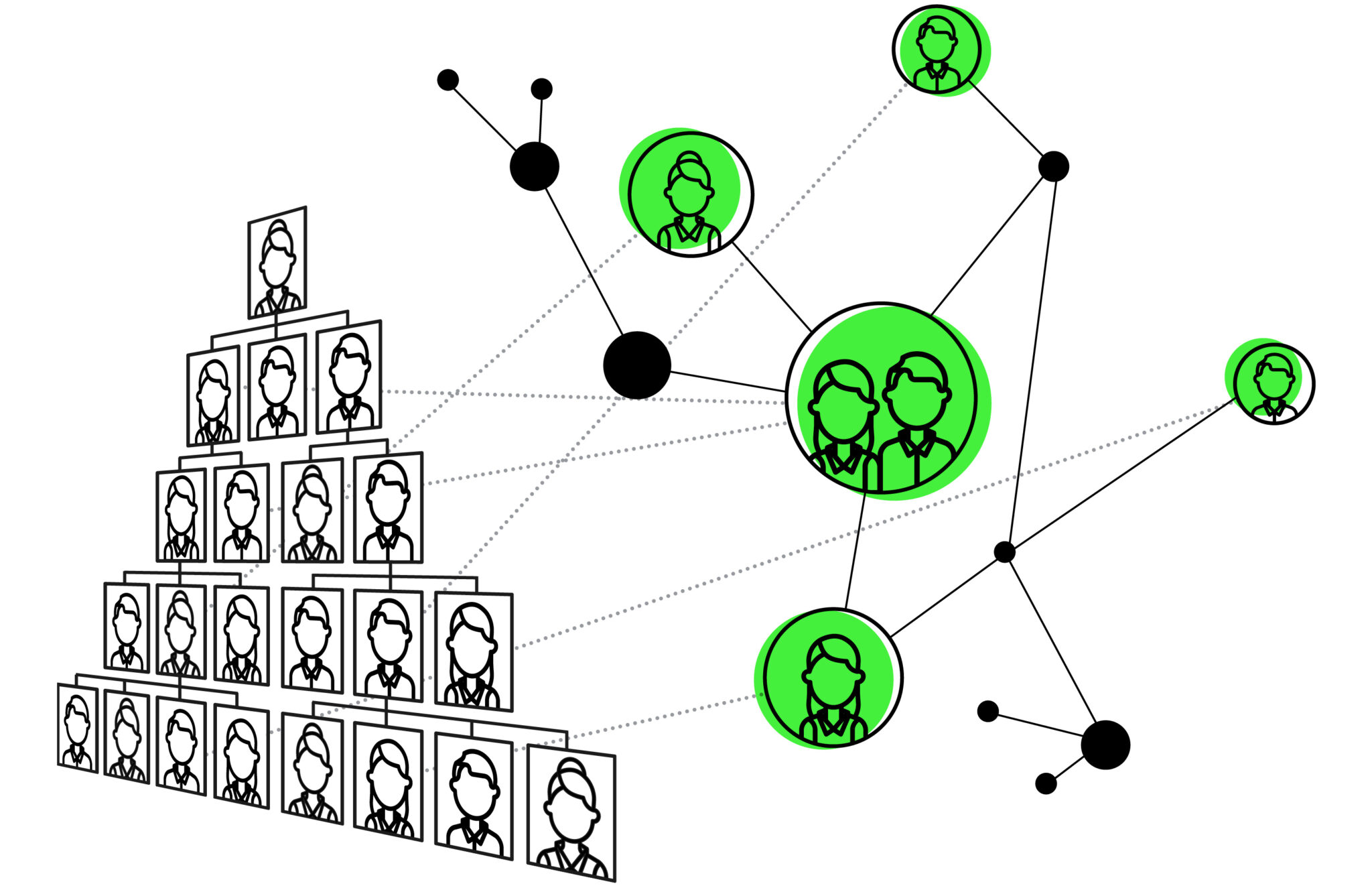Change Management encompasses all the steps involved in changing organizations, IT systems, strategies, values and behaviors in companies.
Change cannot be stopped, but it can be successfully managed. And this is exactly what Change Management is all about: together with our customers, we adapt structures, processes, systems and much more to new, changing market conditions. But only if the adaptation is carried out with the help of a proven change process will the people affected by the change not feel excluded. Only then will managers, employees and shareholders perceive the change as a success for themselves and a benefit for the company as a whole.
Our Change Management makes use of the fact that every change process always goes through very similar Change Management phases. This has already been well documented by scientific theory and studies on change management. Combined with our extensive practical experience and the latest findings from brain research, we can plan most tasks and activities in advance. We then accompany the implementation, adapt measures on an ad hoc basis, measure success and successfully conclude the change process.
- 01 Our Change offer at a glance
- 02 The new formula for Change Management
- 03 Success factor "Security in change projects"
- 04 Success factor "Focus on the change project"
- 05 Success factor "Goals of the transformation"
- 06 Success factor "Highlighting change successes"
- 07 Change initiation: How we start change projects
- 08 Change implementation: How we lead change projects to success
- 09 Known change models
- 10 Things to know about the Change Management
Discuss your project with us:
01 Our Change offer at a glance
Since our foundation, we have dedicated ourselves to the topic of Change Management and, of course, numerous change approaches have inspired us. Whether Kotter, ADCAR or PCI®, each of these models has its strengths in practice - but also its weaknesses. That is why we have developed our own methods and our CPC Change approach over the years: tried and tested, without theoretical baggage, value-adding and based on the latest findings from brain research. In short: an offer with which we lead Change Management projects from A to Z to success.
In terms of the project process, we recommend the Change Initiation phase first. The measures defined there can then be implemented together with you and your employees in the change implementation phase.
Change initiation to set up changes
With Change Initiation, we offer a package of four simple, highly effective modules to analyze and plan your change:

- Change analysis: With the help of Change Legacy, we analyze your experience with previous change initiatives. With Change Impact, we record which areas are affected by the change and how the transformation affects them.
- Development of the change story: Together with the initiating sponsors and key players of the change project, we define the target picture for the transformation. From this, we develop a change story that explains the need for change, the target state and the path to get there.
- Change Network Map: We create transparency about the network between the stakeholders affected by the change. We use the change network map to identify and define local sponsors, change agents and influencers.
- Change architecture: We create the change architecture based on the analysis results, the target image and the network map. It contains all the derived measures that will lead your project to success.
Change initiation has proven itself many times over and is indispensable for any change project. It lays the foundation for fully exploiting the potential of your change project. We then recommend our Change Implementation for the implementation of the change.
Change implementation to realize changes
With Change Implementation, we offer a package of seven highly effective modules to implement your change and lead it to success:

- Change Management Office: As the point of contact for change expertise, the Change Management Office forms the counterpart to Program Management. It is responsible for managing the transformation and ensures acceptance, commitment and sustainability
- Change communication: With target group-oriented communication campaigns, we provide the affected stakeholders with information, impart knowledge and make the transformation tangible. We also make large and small successes visible.
- Change leadership: We support the Guiding Coalition in living out the shared vision and acting as a driver of change. We also empower managers to actively shape and drive change.
- Change Agent Network: We build a network of co-creators with some of the affected employees. We empower these multipliers and implement local change measures together with them.
- User communities: We establish user communities that support each other throughout the entire transformation process. In this way, we create a platform for the effective exchange of knowledge, best practices and information.
- Training & enabling management: We develop a customized training plan for the various employees concerned. In order to generate "aha" effects, we create customized experience formats, training and enabling measures.
- Institutionalization: We ensure that the change know-how is anchored in the organization and that the change can be repeated without external help. We celebrate the successful transformation with everyone involved in a town hall meeting.
Discuss your project with us:
02 The new formula for Change Management
Although there are often claims to the contrary, people and therefore organizations do not like to change. People then talk about the "inner bastard" that they have to overcome. And in companies, those in charge say: "We are a tanker and not a speedboat." These are clear signs of resistance, and it's not surprising. After all, resistance is part of Change Management by definition. We must not only expect it - we have to reckon with it when it comes to change.
But now comes the positive news: resistance is a good thing - we need it to move forward. After all, this is how people and companies decide whether it is worth fighting for change and taking on hardships.
Brain research also suggests that resistance helps people to preserve their patterns of success and only replace them under special conditions. After all, these patterns have meant that we are still alive as a species - so we have done everything right. That's why we don't simply throw the tried and tested overboard for something that we don't even know is successful yet.

Applied to companies, this means that our organization, our systems, strategies, values and behaviours have made us great and successful. We want to and will protect this with good intentions. That is why the all-important question of Change Management is: What do people in organizations need to overcome resistance and embrace something new? What needs to be considered when organizations want or even have to change previously proven patterns of success?

Our new formula for change shows what needs to be considered if organizations want to overcome resistance.
Anne Babilon-Teubenbacher
Partner at CPC

03 Success factor "Security in change projects"
S stands for safety - in the sense of the absence of fear. People who are under stress cannot learn. It has been scientifically proven that the stress hormone cortisol inhibits the brain's ability to learn. And it is the same with organizations: stressed organizations do not learn. If companies are only ever concerned with survival, people cannot develop new behaviors. This contradicts many a management view - for example: "If I stress my employees enough, they will change."

But the exact opposite is the case: creating security is a top management task. Because people can only change in an organization in which managers provide psychological security.
Many managers reply at this point: "That doesn't work, I can't give my employees 100% certainty. Because without pressure, team performance will plummet." But people have learned to deal with pressure all their lives. Pressure can even be a positive motivator to change. However, the limit is crossed when the pressure is so high that people become afraid. Then the brain switches to survival mode, releases cortisol and thus prevents learning.

People need security so that they can learn.
Michael Kempf
Partner at CPC
The tricky thing about fear is that it is very individual and does not follow any rules. Managers need to look at where each individual team member stands. This is the only way they can guide the entire team and ultimately the entire organization through the change.
Security is therefore a necessary organizational prerequisite for Change Management.
Experiences from practice:
In a major reorganization project at a DAX40 company, most managers are seriously worried about their jobs. As a result, they are not in a position to learn. Then they are also expected to support their own employees in the change process. Mission Impossible.
In a major change project, management repeatedly uses warlike associations and terms. "There will be casualties" and "We have to win this battle" are typical statements. They are surprised that people are not interested in the change. Only when they throw the fear language overboard and communicate security, build tension and motivate employees do they win them over.
A large DAX-listed company involves numerous employees in the change process with the help of the so-called "organizational workshop". This is where they get to know the new processes and roles. In the one-day practical workshop, the employees try out the new processes using typical business transactions and practise their own new role. The format conveys the advantages of the changes and allows the disadvantages to be addressed openly. This provides security - both for the employees and for those responsible for the concept.
04 Success factor "Focus on the change project"
Change Management cannot happen simply and succinctly on the side. However, change works very well with focus. For example, if organizations want to change the way they work together but don't focus on it, things will happen as they always have. The likelihood of anything changing in this mode is zero. So what is needed? Companies need maximum focus on change. But who gives a company focus?
First of all, it is the board members and sponsors who direct the organization's focus to a specific topic. Through their involvement in the change story and their presence at information events on the change, employees realize that the topic is important. In this context, we also talk about the "Guiding Coalition", which drives and promotes change. This also means that board members and sponsors are continuously involved, keep working on the change and demand things.

Putting together the "right" change teams

When board members and managers focus on the change project from start to finish, change succeeds.
Michael Babilon-Teubenbacher
Partner at CPC
Experiences from practice:
05 Success factor "Goals of the transformation"
Goals are important in order to assess the difference to the initial situation and to know what is still missing. People in companies need a clearly defined goal so that they can see that they have improved by six percent, for example, but are still nine percent short. This allows them to assess whether they have demonstrably made progress and how many steps still need to be taken. If the goal is vague or consists of wishful thinking, organizations will fail. This is because the people involved need clear feedback that the efforts are worthwhile.
In addition, the goal must benefit people and the organization. An unattractive goal is very difficult, almost impossible, to achieve. The art of Change Management is to formulate a goal that is attractive to the organization, especially at the beginning of the change. The change only has a chance of success if all employees say: "This is worthwhile - I'm happy to do it, even if it's difficult." Typical efficiency improvement targets, ideally combined with the intention of mainly making shareholders happy, are generally of no interest to employees. Defining goals in such a way that they are attractive to all stakeholders is an important success factor for Change Management.

Linking the transformation goals with the corporate values

What we believe in at CPC are goals that have a direct impact on the business.
Gunnar Schultze
Partner at CPC
What we believe in at CPC are goals that have a direct impact on the business. For example, we do not believe it makes sense for a company to change its culture just because it is currently in vogue. A changed culture must be profitable for the business. Change projects without a link to business success will not survive in the organization and will therefore not succeed.
06 Success factor "Highlighting change successes"

Key figures for greater visibility of successes
Discuss your project with us:
07 Change initiation: How we start change projects

We all know by now that changes cannot simply be ordered. Because hardly any employees accept new conditions and simply implement them without thinking about it. And that's actually a good thing.
However, our consulting practice shows that the expectations of companies are still different. Employees are expected to support change without understanding and being explained the deeper meaning behind it (installation).

Change Initiation consists of 4 building blocks

Our change initiation assesses the most important change aspects of the project from various perspectives. It therefore forms the first phase of our tried-and-tested Change Management process and precedes all other change measures and activities. It is a simple, efficient way of approaching change in the right way.
With Change Initiation, we offer a package of four highly effective modules. We bring key people on board and offer them valuable support for the first, fundamental steps in Change Management. Together, we tailor all measures to the specific needs of your company and your employees.
Module 1: Change analysis

In the first module, we analyze your experience with previous change initiatives and analyze your specific change. We interview managers and people selected by you who can provide a meaningful assessment. We conduct the surveys digitally or in person. The change analysis consists of a change legacy analysis and a change impact analysis.With the help of change legacy, we evaluate past changes and gain insights into the success and failure factors of your previous transformations:
- What went well and can be adopted from previous change projects?
- What mistakes from the past should be avoided?
We use change impact analysis to record and examine the strategic effects of change:
- Which different areas are affected by the change?
- How will the transformation affect the different areas? Will the number of employees change depending on the area? Do managers have to adapt their leadership behavior? Do employees need to expand their skills? And much more.
The change analysis therefore helps to take past critical success factors into account and to identify the areas and stakeholder groups that are significantly affected. Accordingly, more or more intensive measures are planned for stakeholders who are more affected by the change.
Module 2: Developing the change story

The change story makes clear the need for change and the associated impact on the company and its departments. It also explains the target state and the path to get there. In this way, it provides orientation for all employees affected by the change and promotes their understanding of the transformation.
We create the change story with the initiating sponsors and key players of the change project. Together, we develop the story and describe the target image for the transformation. This is not always easy. After all, the sponsors typically have very different expectations of the change. The process of agreeing on a common vision is part of developing the story. However, this ensures that all sponsors communicate the same story.
The positive impact of the change story is particularly effective if it is visionary and inspiring. It should also be easy to understand and clearly formulated so that all employees understand the reason for the change. Ideally, it should also show employees ways in which they can support the implementation of the change.
In addition, cooperation with the sponsors also creates an understanding of the connection between Change Management and the success of the project. The change story should answer these questions:
- Why is change necessary and why can't things stay the way they are?
- What will our company look like after a successful implementation?
- What steps need to be taken to implement the change?
Module 3: Development of the Change Network Map

Module 4: Change architecture

- Involving the affected employees in the solution design
- Communication for the different target groups
- Training & enabling of those involved
- Recognition and reward.
Change Initiation offers numerous advantages
Change initiation is the first important step for change projects. It connects sponsors and other important stakeholders of the change. It also makes the opportunities of the change tangible for everyone involved. As a result, it provides the change architecture that is necessary to implement the Change Management in your project.
Change initiation has proven itself many times over and is indispensable for any change project. Fully exploit the potential of your change project and increase the probability of success!
We then recommend our Change Implementation for the implementation of the change.
Discuss your project with us:
08 Change implementation: How we lead change projects to success

Module 1: Change Management Office

- Derivation of change measures from the change impact analysis for the various areas. To put it simply: the more changes for employees, the more measures we plan.
- Avoiding the watering can principle and informing employees not affected by the change at an early stage
- Responsible for defining, planning and controlling necessary change activities in close coordination with program management
- Implementation of change measures as well as monitoring and effectiveness tracking in sprints. This enables us to react quickly to changing situations and meet the needs of the target groups concerned.
- Responsible for stakeholder management and coordination of change networks
Module 2: Change Communication

- Development of a communication plan
- Target group-oriented communication measures to make the change tangible and impart knowledge
- Derivation of target group-specific micro stories from the change story. In this way, we create awareness and acceptance in the various stakeholder groups and areas
- Development and implementation of communication channels
- Searching for and writing success stories. These are small and large successes from the project - in the form of texts, audios or videos. They document the commitment to change and show everyone involved: it works!
Module 3: Change Leadership

- Supporting the Guiding Coalition in exemplifying the common vision and acting as a driver of change
- Empowering the leadership roles identified with the help of the Change Network Map to actively shape and drive change
- Establishing a communication and exchange platform for managers
Module 4: Change Agent Network

- Identification of local drivers for change. The basis for this is the Change Network Map
- Establishing and enabling the change agent network
- Implementation of local change measures in collaboration with the change agents
- Identification and resolution of obstacles to implementation in the local organizational units
Module 5: User Communities

- Building user communities with similar challenges that support each other throughout the transformation
- Measures to involve the affected employees to ensure their acceptance and commitment
- Creating a communication platform for the effective exchange of knowledge and best practices
Module 6: Training & Enabling Management

- Analysis of enabling needs and skills gaps based on the change impact analysis
- Development of a customized training plan for the various affected areas and employees. We pay particular attention to ensuring that those affected acquire the skills they need at the right time and in the right way.
- Creation or co-creation of customized experience formats and enabling measures
- Managing and measuring the success of formats and measures
Module 7: Institutionalization

- Ensure that change know-how is anchored in the organization and that changes can be repeated without external help
- Organizing and holding a town hall meeting to celebrate the achievements
- Documentation of lessons learned together with the Guiding Coalition
Change implementation allows you to fully exploit the potential of your change project. You achieve the desired, sustainable change in the company because your employees support and help shape the company's new direction.
Discuss your project with us:
09 Well-known Change Management models
Kurt Lewin's 3-phase model
- Thawing phase: First, the willingness to change is brought about by convincing those affected of the need for change.
- Change phase: The actual initial state is then redesigned.
- Freezing phase: Finally, the change is stabilized and anchored within the organization.
The 8-step model by John P. Kotter

- Create a sense of urgency: Help others recognize the need for change and the importance of immediate action.
- Establish a leading change coalition: Assemble a team of respected leaders who will motivate for change, but not bring it about themselves. The entire organization must feel responsible for the change.
- Develop a vision of change and a strategy for this change: Clarify how the future differs from the past and how the future will become reality. The vision must be clear, plausible and inspiring.
- Promote understanding and acceptance and communicate on a broad basis: Ensure that as many others as possible understand and accept the objectives and strategy. Set an example and communicate it credibly.
- Create freedom of action and empowerment on as broad a basis as possible: Remove as many obstacles as possible so that the change team has a free hand in realizing the goals. Stop key players if they are demonstrably acting against the change.
- Ensure short-term success: Achieve some visible, clear successes and performance improvements as quickly as possible.
- Do not let up in achieving goals and successes: Persistently implement one change after another until the goal is realized.
- Anchoring the changes achieved in the corporate culture: Ensure the success of the new behaviors until they have replaced the old behavior.
Accelerate by John P. Kotter
- Accelerators are omnipresent aspects to be considered instead of a sequential process.
- Accelerators integrate as many people as possible instead of forming small groups.
- Accelerators need the flexibility and agility of a network instead of classic, hierarchical structures.

The ADKAR model
- Awareness: Those affected recognize the need for change.
- Desire: Those affected participate in the change and support it.
- Knowledge: Those affected have the necessary knowledge to change.
- Ability: Those affected have the ability to implement necessary behaviors.
- Reinforcement: Those affected reinforce their behaviour in order to stabilize the change.
People Centered Implementation (PCI®)
- Shared change purpose: The current situation and the resulting need for change are formulated. The purpose is then communicated within the organization in such a way that a critical mass of those affected are convinced of the need for change.
- Effective change leadership: A network of capable and responsible change leaders is now put together. They define the direction and process of the change and are available to provide support.
- Powerful Engagement Process: This is followed by the implementation of planned communication, reward and development activities. This increases the commitment of all those involved.
- Committed local sponsors: Sponsors are needed to further strengthen the change. Middle and line managers are equipped with the necessary skills and motivation to act as role models for their employees.
- Strong Personal Connection: The aforementioned "role models" implement specific strategies to increase commitment and develop the skills of their employees.
- Sustained Personal Performance: Middle and line managers are empowered to support their employees in implementing the change. Employees fully accept the change and drive it forward effectively.
Discuss your project with us:
10 Things to know about Change Management
01 Definitions of Change Management
- Change ManagementThe process, tools and techniques to manage the people affected by change and achieve a desired business outcome. Prosci®
- Change Management are a set of principles, techniques and rules that are applied to the human aspects of implementing major change initiatives in organizations. Daryl R. Conner
- Change Management is a systematic approach to dealing with change. Both from the perspective of a company and at the individual level. PMI® Project Management Institute
02 Origin of Change Management
03 Frequent occasions for Change Management
- Digitization of business models
- Implementation of a new corporate culture
- Implementation of SAP S/4 HANA and other ERP systems
- Optimization of the organization and business processes
- Sustainability transformation
- Introduction of agile organizational structures
- Global strategy rollout
- Introduction of AI systems
- Staff restructuring
- Implementation of cost reduction programs
04 Goals of the Change Management
05 The change curve in the Change Management

- Phase 1 - Surprise & Denial (Surprise & Denial): After the initial surprise at the announcement of the change, many employees react defensively and push the change aside. This is because they believe that the transformation is not necessary or will fail.
- Phase 2 - Realize Start Of Change: Many employees react with frustration and anger. They realize that their environment is actually starting to change or that they are suddenly being asked to do things differently against their convictions. Some of them even start to fight against the change.
- Phase 3 - Bargaining (negotiation): After reaching the lowest, emotional point, people start to negotiate with themselves: "Which parts of the change sound acceptable to me, which parts will I never accept?"
- Phase 4 - Try-Out & Commitment: At some point, those affected then take the first active step and test the new solution. If the test experience is positive, they build up commitment to the new solution. As a result, they stop working with the old processes and tools. Not because they have to, but because they want to.
- Phase 5 - Future state (target state): An employee has completed the curve and reached the target state when the change has become commonplace for them.
06 Resistors in the Change Management
07 Phases and processes in the Change Management
08 Success factors in the Change Management
- Emphasize the urgency for change and the overarching vision of a changed and better target state.
- Define a schedule for the change process and a time frame for the individual process steps and the overall project.
- Carry out communication measures and promotional campaigns in order to optimally reach the employees affected by and involved in the change.
- Plan for early successes and make them visible within the company.
- Mobilize top management for successful implementation and commit them to a common goal.
- Identify all those involved and affected with the help of a stakeholder analysis.
- Analyze social relationships within the organization, recruit change agents and integrate them into the change process.
- Prepare the people in the company for the upcoming change and convince them of the opportunities it brings in order to minimize resistance.
- Involve affected employees in the change through experience formats and make the current status and target status transparent in order to increase employee engagement.
- Regularly measure the acceptance of the change project and initiate improvement measures.
- Continuously identify and remove obstacles that hinder change.
- Anchoring the change process in the company at an early stage in order to tackle subsequent changes in a structured manner.
Discuss your project with us: